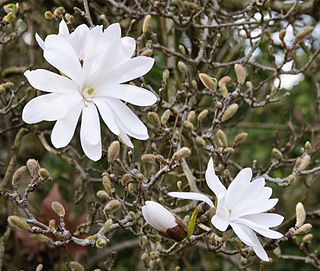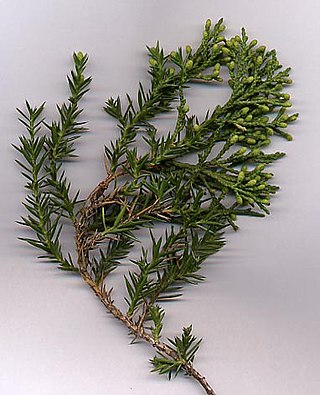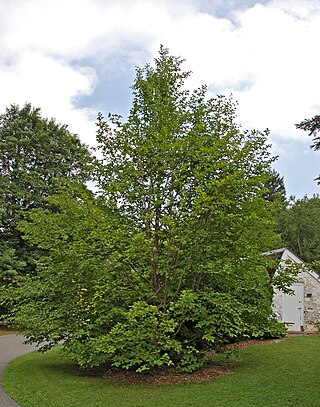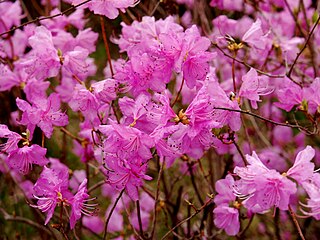
Magnolia stellata, the star magnolia, is a slow-growing deciduous shrub or small tree native to Japan. It bears large, showy white or pink flowers in early spring, before its leaves open. This species is closely related to the Kobushi magnolia, and is treated by many botanists as a variety or even a cultivar of that. However, Magnolia stellata was accepted as a distinct species in the 1998 monograph by Hunt.

Acer micranthum, the small-leaved maple, is a species of flowering plant in the family Sapindaceae in the snakebark maple group, native to Japan, on Honshū, Kyūshū and Shikoku. Its Japanese name is the Komine maple.

Koelreuteria paniculata is a species of flowering plant in the family Sapindaceae, native to eastern Asia. It was introduced in Europe in 1747, and to America in 1763, and has become a popular landscape tree worldwide. Common names include goldenrain tree, pride of India, China tree, and the varnish tree.

Juniperus chinensis, the Chinese juniper is a species of plant in the cypress family Cupressaceae, native to China, Myanmar, Japan, Korea and the Russian Far East. Growing 1–20 metres tall, it is a very variable coniferous evergreen tree or shrub.

Aralia spinosa, commonly known as devil's walking stick, is a woody species of plant in the genus Aralia, family Araliaceae, native to eastern North America. The various names refer to the viciously sharp, spiny stems, petioles, and even leaf midribs. It has also been known as Angelica-tree.

Kalopanax septemlobus, common names castor aralia, tree aralia, and prickly castor oil tree, is a deciduous tree in the family Araliaceae, the sole species in the genus Kalopanax. It is native to northeastern Asia, from Sakhalin and Japan west to southwestern China. It is called cìqiū (刺楸) in Chinese, eumnamu (엄나무) in Korean, and harigiri in Japanese.

Yucca filamentosa, Adam's needle and thread, is a species of flowering plant in the family Asparagaceae native to the southeastern United States. Growing to 3 metres tall, it is an evergreen shrub valued in horticulture.

Aralia cordata is an upright herbaceous perennial plant growing up to 2 to 3 metres in height, native to Japan, Korea, Russian Far East, and eastern China. Its common names include spikenard, herbal aralia, udo, Japanese spikenard, and mountain asparagus. It is commonly found on the slopes of wooded embankments. Aralia cordata is a species of Aralia in the family Araliaceae.

Dracaena reflexa is a tree native to Mozambique, Madagascar, Mauritius, and other nearby islands of the Indian Ocean. It is widely grown as an ornamental plant and houseplant, valued for its richly coloured, evergreen leaves, and thick, irregular stems.

Allium monanthum, the Korean wild chive, is a spring vegetable with minuscule bulbous roots that have a mild onion flavor and found in the woodlands of Korea, Japan, northeastern Russia (Primorye), and northeastern China.

× Fatshedera is hybrid genus of flowering plants, common name tree ivy or aralia ivy. It has only one species, × Fatshedera lizei. The hybrid symbol × in front of the name indicates that this is an inter-generic hybrid, a cross between plants from different genera. The name may be displayed with or without a space after the × symbol.

Fatsia japonica, also fatsi, paperplant, false castor oil plant, or Japanese aralia, is a species of flowering plant in the family Araliaceae, native to southern Japan and southern Korea.

Acer japonicum, Fullmoon Maple, Downy Japanese-Maple, is a species of maple native to Japan, on Honshū, Hokkaidō, Kyūshū, and also southern Korea.

Stewartia pseudocamellia, also known as Korean stewartia, Japanese stewartia, or deciduous camellia, is a species of flowering plant in the family Theaceae, native to Japan and Korea.

Aucuba japonica, commonly called spotted laurel, Japanese laurel, Japanese aucuba or gold dust plant (U.S.), is a shrub native to rich forest soils of moist valleys, thickets, by streams and near shaded moist rocks in China, Korea, and Japan. This is the species of Aucuba commonly seen in gardens - often in variegated form. The leaves are opposite, broad lanceolate, 5–8 cm (2.0–3.1 in) long and 2–5 cm (0.79–1.97 in) wide. Aucuba japonica are dioecious. The flowers are small, 4–8 mm (0.16–0.31 in) diameter, each with four purplish-brown petals; they are produced in clusters of 10-30 in a loose cyme. The fruit is a red drupe approximately 1 cm (0.39 in) in diameter that is avoided by birds.

Forsythia × intermedia, or border forsythia, is an ornamental deciduous shrub of garden origin.

Acer palmatum, commonly known as Japanese maple, palmate maple, or smooth Japanese maple (Korean: danpungnamu, 단풍나무, Japanese: irohamomiji, イロハモミジ, or momiji,, is a species of woody plant native to Korea, Japan, China, eastern Mongolia, and southeast Russia. Many different cultivars of this maple have been selected and they are grown worldwide for their large variety of attractive forms, leaf shapes, and spectacular colors.

Zanthoxylum piperitum, also known as Japanese pepper or Japanese prickly-ash is a deciduous aromatic spiny shrub or small tree of the citrus and rue family Rutaceae, native to Japan and Korea.

Rhododendron mucronulatum, the Korean rhododendron or Korean rosebay, is a rhododendron species native to Korea, Mongolia, Russia, and parts of northern China. It is a deciduous shrub that grows to 1–2 m (3.3–6.6 ft) in height, with elliptic or elliptic-lanceolate leaves, 3–7 cm long by 1–3.5 cm wide. The reddish-purple flowers appear in late winter or early spring, often on the bare branches before the foliage unfurls. It inhabits forested regions at 1,600–2,300 m (5,200–7,500 ft).

Zelkova serrata is a species of the genus Zelkova native to Japan, Korea, eastern China and Taiwan. It is often grown as an ornamental tree, and used in bonsai. There are two varieties, Zelkova serrata var. serrata in Japan and mainland eastern Asia, and Zelkova serrata var. tarokoensis (Hayata) Li on Taiwan which differs from the type in its smaller leaves with less deeply cut serration on the margins.




























